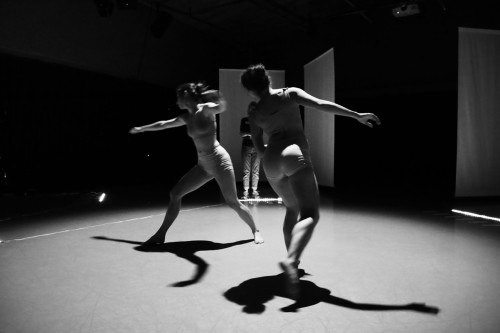 United Kingdom Resolution! 2014 – Point of View; Disc of Light; Frame: Thea Stanton DANCE, Mildred Rambaud, fiftyfifty, The Place, London, 5.2.2014 (JO’D)
United Kingdom Resolution! 2014 – Point of View; Disc of Light; Frame: Thea Stanton DANCE, Mildred Rambaud, fiftyfifty, The Place, London, 5.2.2014 (JO’D)

Point of View
Performers: Ester Braga, Marie Michele Tessier
Technical: The Place
Film Editor: Nick Wilding
Music: Timothy Cape, Fred Feene
Disc of Light
Performers: Beatričė Bukantytė, Katsura Isobe, Mildred Rambaud
Dramaturgy: Selina Papoutseli
Lighting Design: Ansgar Pruwer
Music: Alfred Rambaud
Costume design: Franziska Haenssler
Frame
Performers: Alex Newton, Noora Kela, Anthony Kurt-Gabel, Grace Hann, Stephen Wilson
Lighting Design: Gareth Green
Music choice by: Laurence Cumming
For the past twenty-five years, Resolution! (The Place’s annual ‘platform for new dance’) has been a space for young choreographers to show their work. The website refers to it as ‘a starting point’ for, among others, Russell Maliphant, Jasmin Vardimon and Hofesh Shechter. ‘You may be looking at tomorrow’s choreographers, tonight,’ said Deputy Director, Adam Pushkin, as he introduced the three, short dance pieces that made up that evening’s instalment.
The first, Point of View, by Thea Stanton DANCE, begins promisingly with close ups of different parts of two women dancers’ moving bodies (head, knee, shoulder, etc.), projected in squares onto a screen at the back of the stage. The number of squares gradually reduces to leave only two, large images of the dancers’ waists. When the dancers themselves appear, they are standing one in front of the other, facing the audience. Dressed almost identically, they bend forward in unison then regain an upright position in time to the throbbing, pulsing, electronic soundtrack. The piece becomes less interesting when the two women move apart to perform solos in which they develop a ‘centre of movement’ in a particular part of the body (right hand, left knee, right palm). Tension returns when they dance together again, making unexpected contact (the forehead of one with the knee of the other, for example). The ending is a challenge. Standing side by side, bending slowly forwards and upwards as they did at the start, the two dancers remain on the stage, continuing their movement, even after people had clapped a second time. It was the audience who had to leave the auditorium (for the interval) first.
The three women in Mildred Rambaud’s Disc of Light appear against a velvety darkness, hidden to various degrees by the large discs they hold in front of them. These are silver-coloured on one side, copper-coloured on the other. Moving slowly around each other, the women (in long dresses that resemble those worn by figures in Surrealist painting from the 1930s) crouch behind their disc and show one hand above its rim, or carry it in front of them like a tray, or hold it behind their heads like a halo as they turn on the spot. Held at different angles, and at different distances from the audience, the discs reflect light in different colours and in different ways. They could be planets. The women could be goddesses. All three have the detached air of deities, certainly, as they move carefully around each other. The piece builds to an enigmatic and thrilling climax. One woman, holding the disc over her head in the shape of a cone, spins with increasing speed; then falls. The other stands immobile. The third, her back to the audience, walks slowly into the darkness.
The final work, Frame, was described in a brief introduction from the stage by choreographer, Anthony Kurt-Gabel, as ‘four experiments’. It would be the first time that the dancers heard the music. (They had rehearsed to a tape of harpsichordist and conductor, Laurence Cumming, ‘reading’ the Baroque score.) The three women and two men (one of them the choreographer himself) may have been injected with a burst of energy from the sound of the music. This may explain the crispness to what was the most ‘danced’ piece of the three. Kurt-Gabel asks his dancers to execute fast, stabbing movements. Alex Newton and Noora Kela (who are credited as co-choreographers) invest these with an emotional layer. In the second of the four experiments, Kurt-Gabel sits on a chair at the front of the stage, his sharply imploding body contrasting with the Baroque harmonies being played. Though for me the ending to Disc of Light had power, this was the one moment of the evening to be greeted with spontaneous applause.
John O’Dwyer